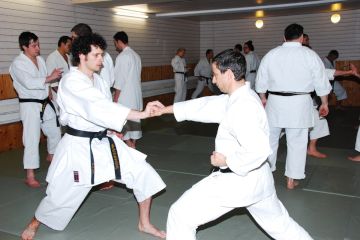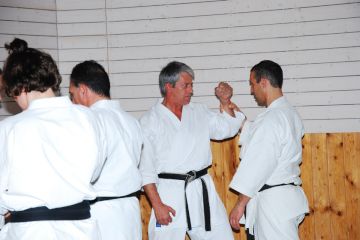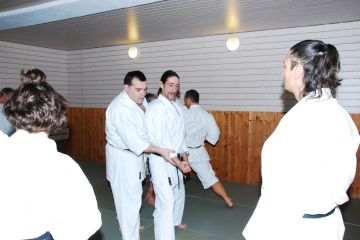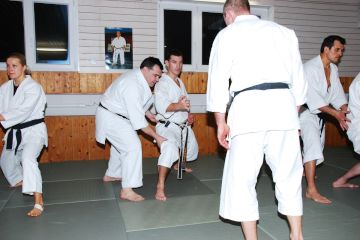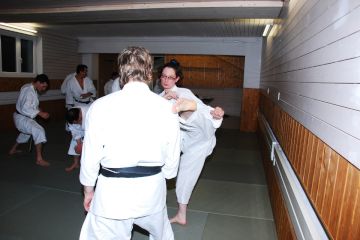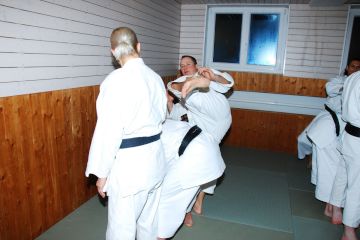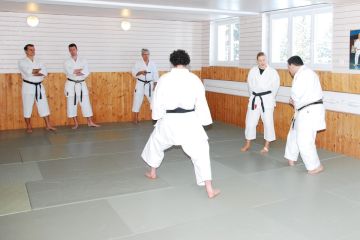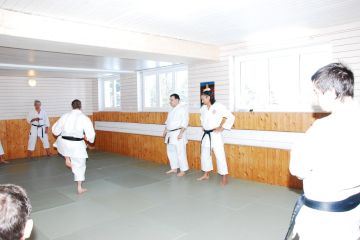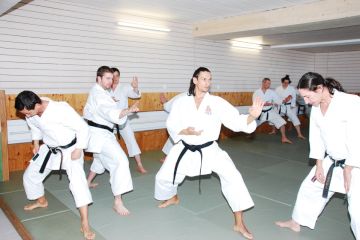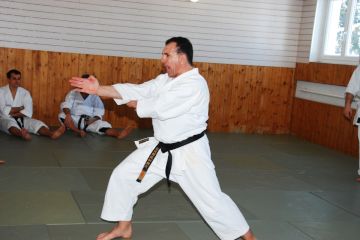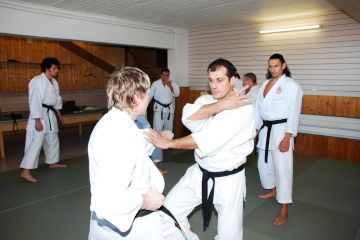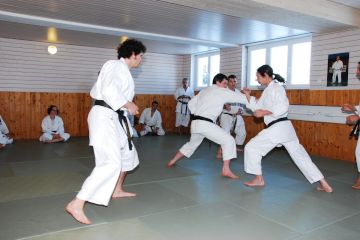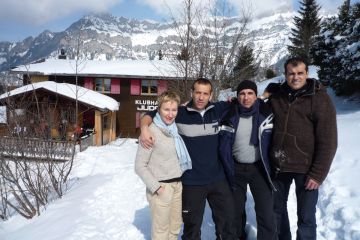Instructor Kangeiko 2010 in Eggberge / Switzerland
KSKA hosted the second instructor Kangeiko in Eggberge 12-14 March 2010, where around 20 participants were invited. Most of the karatekas were 3rd to 5th dan and we came from Spain, Portugal, France, Germany, Italy, Belgium, United Kingdom, Finland and Luxembourg.
The instructor of the weekend was Sensei Pascal Petrella member of KSKA Shihankai, who is also a true talent in organisation and logistics, which became apparent from the beginning. There was a pick up service from the airports of Basel and Zürich, where I by chance met Juan Pablo, Manolo, Jani and Taija, Reinaldo, Freya and Lorenzo. After a nice relaxed chat, we headed to the meeting point and there we met the group coming from Germany and Basel. Our convoy arrived in Flüelen at 16.59 and the cable car left at 17.00. I call that a good timing!
After a steep rise along the cliff in the cable car, we were welcomed by fresh clear air and a small village covered by high banks of pure white snow. The weather was surprisingly mild (for a Finn), my guess is around 0 degrees. A big sledge was waiting for us to carry the food and drinks to the Judo-House Eggberge. The house lies on a mountainside, 1450m above sea level in beautiful surroundings, close to a ski lift and a bar. In the house, the rooms were allocated and the gi's unpacked. Pascal with his sous-chef Claudia made quick preparations for dinner and then it was time for the first session.
I was the dedicated reporter of the weekend. Due to a knee problem, I was this time using a pen & camera instead of my body.
1st training Fri 6pm: Mistakes - See & correct them
The first session was technical, in consideration of those, whose voyage started the day before. The main goal was to sensitize instructors and give them teaching tools and methods, especially in order to enlighten: How to see mistakes and how to correct & remove them?
Sensei Pascal started with a simple example zenkutsu dachi (ZKD) and its typical mistakes e.g. the position of the front foot. This was still easy to correct. When pushing the knee forward one cannot turn the foot. Then we dealt signaling with the upper body movement and moving up & down. One task was to observe and learn to see subtle indications for underlying problems and mistakes. With this learning by practising & observing method, we processed age-uke, mae-geri and mawashi-geri. Sensei Pascal gave various kihon and kumite exercises to do and new proposals how to correct typical mistakes of these basic techniques.
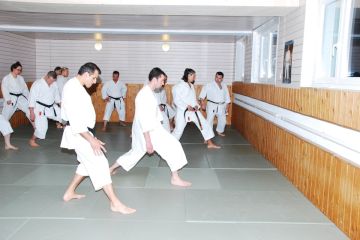
Sensei Christian LeRomancer and sensei Benoît from France |

Sensei Pascal Petrella during a demostration for correct foot work |
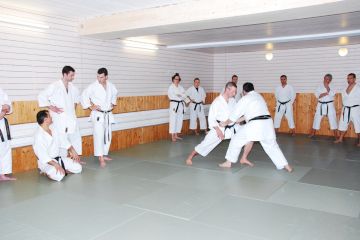
Exercise how to check the stability of zenkutsu dachi |
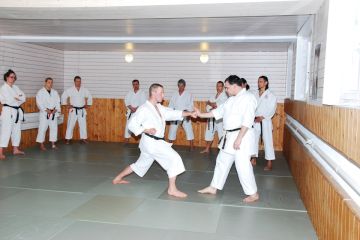
The power must be transferred from the heel to the fist |
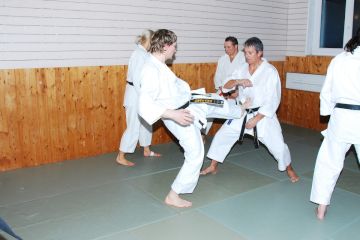
Gerhard Scheuriker from Germany kicks a good mae-geri |
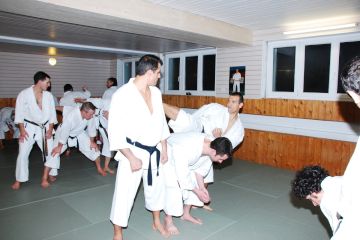
Sensei Juan-Pablo Delgado from Spain delivers a mawashi-geri |
After training, the chefs Pascal and Claudia prepared a delicious and long-awaited dinner. Jerome from France had brought an original and strong Calvados from his family estate. After a couple of no thank you's I took a cautious sip and found the nectar (very) delightful. For Lorenzo Marti it had an effect like the sweetest lullaby. Luckily, one thing led to an other and in the end we were laughing and singing so loud that everybody stayed awake, some late, some very late.
2nd training Sat 10am: Teaching Kata
The second training started with the topics we learned on Friday, see the mistakes, and how to correct them. Some of us had to show some kihon and some needed to show how they could apply what they have learned the day before.
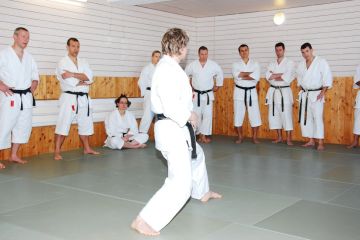
Sensei Gerhard Scheuriker from Germany |
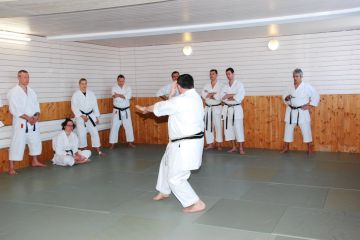
Sensei Pascal Petrella explains |
The kata of the day was Heian Nidan. First we started with its basic positions ZKD and Kokutsu dachi (KKD). With partner exercises we fine-tuned relaxed and natural positions combined with a technique.
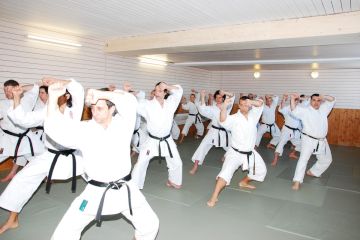
Group with Heian Nidan |
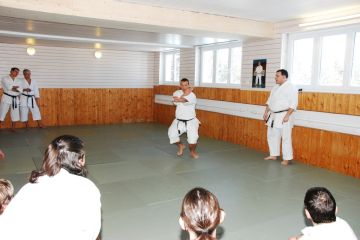
Sensei Juan-Pablo Delgado from Spain |
Then Sensei Pascal gave us different options, how to teach a kata for different levels. We kept in mind the main goal of the weekend i.e. how to see a mistake and how to correct it. For instance, with KKD some basic mistakes are circular movements, knee turning in, direction of the feet, and problems linked to moving forward and back or to performing shuto-uke. Sensei Pascal guided us through a number of exercises with which everybody can help their students (and themselves) and ways of doing them depending on, if your students are children, junior or senior (+40) karatekas. Then we practised the kata in sequences and in full.
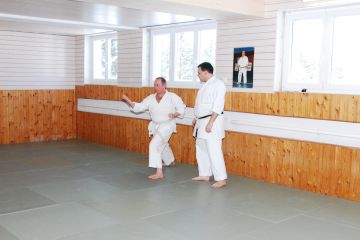
Sensei Oliver Sprinz from Germany |
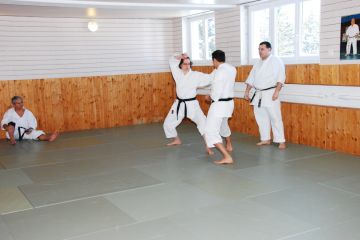
Freya Geurts from Belgium and sensei Christian LeRomance |
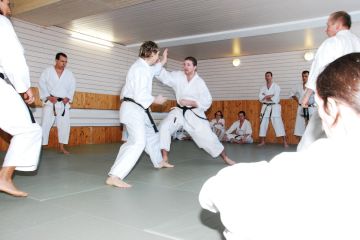
Sensei Gerhard Scheuriker from Germany |
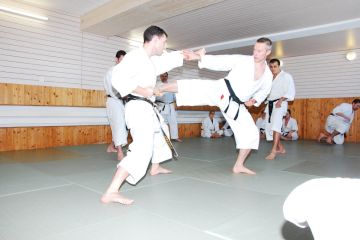
Sensei Nico Ibscher from Germany applies a yoko-geri kekomi |
Next, we turned to kata bunkai. Here again there were different options for e.g. blue belt level, shodans or higher belts. An example for an exercise for 3rd dan's & upwards. The concept was reality: How do we function, when really tired or hurt. One person was doing the full bunkai (own choice of applications) and 4 were attacking. Once slow, then fast, and hajime and hajime repeatedly, until one cannot think anymore and action becomes automatic. Lorenzo, Gerhard and Nico went to their limits and beyond.
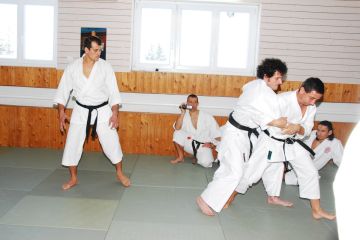
Sensei Miguel Rocha from Portugal applies a throwing technique |
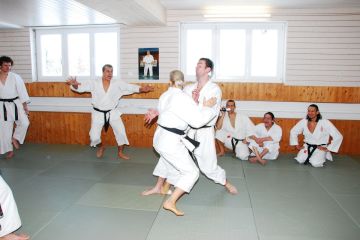
Sensei Taja Somppi from Finland during bunkai |
Finally, we moved on a random attack scenario when entering a bar. Task was to choose and apply efficiently a simple and practical bunkai. After this realistic practise, I can say that I am happy to go to a bar with Freya and Taija any time. J
After lunch, we headed out. The weather was as beautiful as it can be. These are the moments when I wish I were a poet: Brightness of the sun, clearest blue in the sky, sparkling white snow and view so majestic, magnificent, so overwhelming that I stand in awe. Far down, you can see the clear blue mountain lake; in high, the tremendous austere mountains reach the skies all around you. You just stand there and try to take it all in. Pure beauty.
During the break, some took a walk in the trails or fell in to the deep snow banks like Christian, Juan Pablo and Manolo; others were sun bathing like Nico, Gerhard, Carlos and Reinaldo.
3rd training 4.30 pm: Stretching by Sensei Nico Ibscher
Sensei Nico shared with us the newest scientific knowledge on stretching applied to karate training. Based on a target-oriented approach, he gave us different warming up methods for various training purposes and explained what are beneficial or contra productive methods and why (e.g. static, dynamic and combined methods). During discussion, we were able to learn everything we ever wanted to know about stretching but were afraid to ask J
Kase blocks by Sensei Pascal 5.30 - 8pm
This session was very physical. We practised the 8 closed hand blocks, concentrating on kumite mind, de-ai timing, breathing, kime and attobaya. Sensei Pascal taught us exercises, how to train these essential skills e.g. how to move fast and relaxed and create attobaya feeling that split moment when necessary. It was a heavy interplay with kihon and kumite.
The session was so dynamic and energetic that the dojo's air was visible steam when we opened the windows. I thought I had a vision of Nico's aura, but he was just steaming as if coming out of the sauna. The kime and energy were touchable, the satisfaction of the group as well.
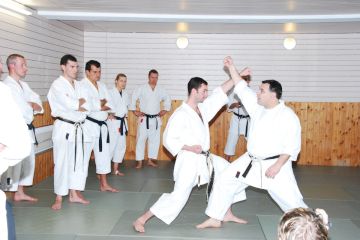
Sensei Pascal Petrella demonstrates the importance of timing |
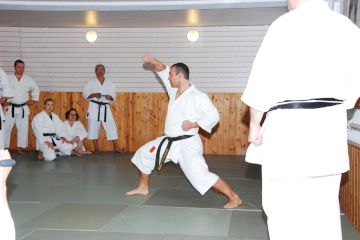
Sensei Juan-Pablo Delgado from Spain shows age-uke |

Sensei Ashley Coburn right during practice of attobaya |
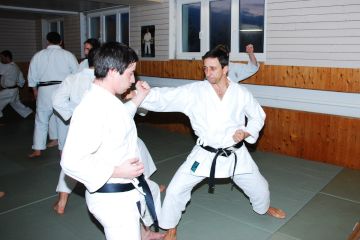
Sensei Michael Cooper from England with uchi-uke |
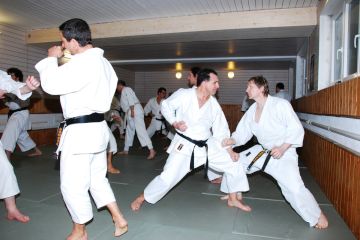
Sensei Gerhard Scheuriker from Germany with otoshi-uke |
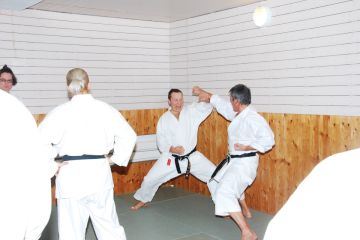
Sensei Jani Somppi from Finalnd with age-uke |
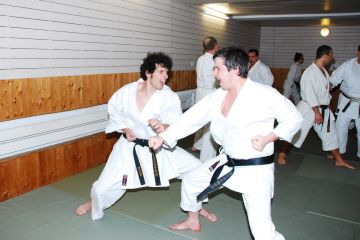
Sensei Lorenzo Moruzzi, Belgium with soto-ude-uke |
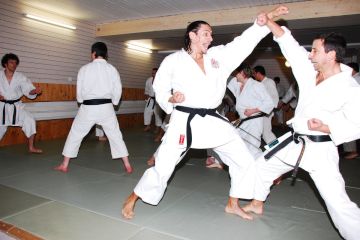
Sensei Carlos DiMarco, Italy |
What can I say first Freya's Sambucca gave a sweet kick on my empty stomach. Then the fiery Roehmentopf dinner was accompanied with excellent company, laughter, interesting discussions, stories and of course some heavy singing as well as reiki treatments. Still now, the Kangeiko song's forceful rhythm is ringing or rather pounding in my ears. Sensei Jani even became a conductor and inspired all along to sing - in Finnish.
4th session Sun 8am: How to build up kumite with kyu grades
This session was an overall entity, giving us a concept of how to gradually build up kumite skills. We started with some ippon kumite exercises for white/yellow belts and gohon kumite for orange/green belts. Then we went on with more complex kaeshi-ippon kumite exercises for blue/brown belts and finally ended with jiyu ippon kumite concentrating in developing speed and power. The final purpose of all the different kumite forms was the preparation of the go no sen -timing. Other focus points were ability to see, proper body positions, efficient techniques and spirit.
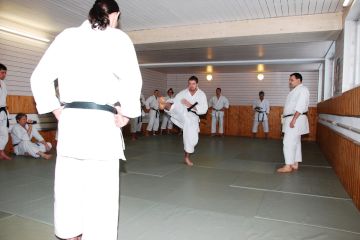
Sunday morning sensei Ashley from England has to demonstrate mae-geri |
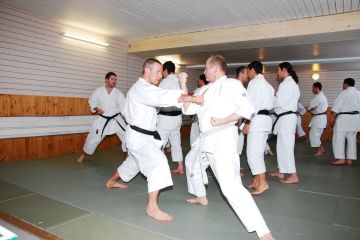
Sensei Nico Ibscher und sensei Oliver Sprinz from Germany |
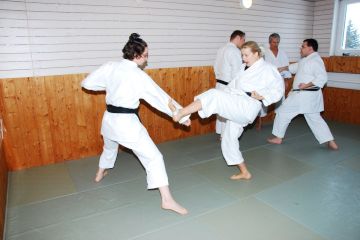
Freya Geurts, Belgium with Gedan Barai |
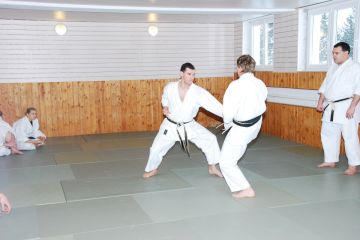
Sensei Jerome Le Houedec, France with a go-no-sen block |

Sensei Ashley Coburn and sensei Miguel Rocha |
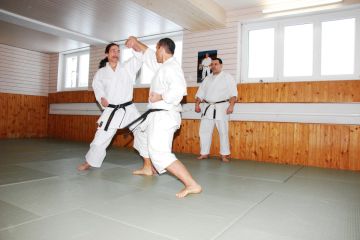
Sensei Lorenzo Martin and sensei Juan-Pablo Delgado from Spain |
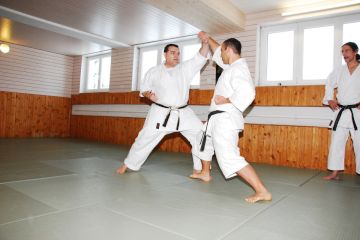
Sensei Pascal Petrella with age-uke |
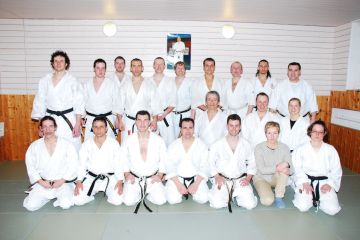
KSKA Kangeiko 2010 Group Photo |
After a quick and early lunch it was time to clean up, pack and go. The journey back to the airport was rather contemplative. You know the feeling after a great karate weekend. I realised that we had gone through all of
The eight Phrases for the Secret of the Fist
The mind synchronises with Heaven and Earth,
And blood flows along with the sun and moon,
This art requires hardness with softness in one breath,
The body moves in time and adapts to change.
The fist attacks, surprising his unguarded moment,
The feet measure, determining my advance and retreat.
The eyes need to survey sight in four fronts,
And the ears listen to sound from eight directions.
Big thank you and OSS
Anne Rasimus
EU Karate Club Luxembourg

